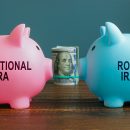7 Investments to Consider For A Comfortable Retirement

Saving for retirement is a critical activity that everyone must undertake to secure a happy post-retirement life. You need to start saving early to create a significant retirement nest egg for yourself and pick the right investment instruments to do so. This can be a bit tricky as there are so many retirement investment options available to choose from. Everyone has unique financial needs so an investment option that may be suitable for your friend or a family member, may not be the best option for you. You also need to consider factors such as income eligibility for retirement tax accounts, tax implications, withdrawal restrictions, and more when planning for retirement as they play a crucial role in securing your retirement years.
Retirement planning has undergone a significant change over the years due to factors such as increased life expectancy and a steady increase in inflation. For example, a retiree in the United States had a possible lifespan of 14 years previously which has increased to 20 years. This means that you need to save a much higher sum of money for retirement compared to earlier generations. Another factor that is an issue is the rising inflation rate. The inflation touched a 40-year record high in February 2022 when it stood at 7.9%. Financial experts are painting a grim picture wherein an individual who earns $40,000 in pension each year may lose at least 25% of this value (in real dollars) within three years at the present rate of inflation. If this trend continues, any macro-economic events or pandemic situations such as the COVID-19 that might occur in the future may greatly exacerbate the loss of your retirement fund in real dollar terms.
However, if you take preventive steps, you may soften the impact of inflation and create a substantial retirement corpus for yourself. Pick the right investments for your retirement to maximize your savings. For example, you might be investing a certain amount of money in a non-tax advantaged account meaning any earnings you accrue may be taxable at the time of making a withdrawal in retirement. Invest in tax-advantaged retirement accounts, such as a 401(k), an IRA (Individual Retirement Account), Roth IRA, etc., where you can benefit from tax-free growth and tax-free withdrawals (in case of certain accounts provided you meet the conditions), and more so, earn significantly high returns while lowering your tax burden in the long run. Keep in mind that your choice of assets, portfolio composition, selection of retirement accounts, and more have a direct influence on your retirement savings.
Your choice of investments depends on your risk tolerance, age, standard of living, and how much you wish to earn. To create a customized retirement investment strategy that fits your investment philosophy and would help you attain your financial goals and needs, engage the services of a professional financial advisor who may advise you on the same.
Let us discuss the seven best investments for retirees that can help make your retirement years comfortable and financially secure:
1. Maximize your savings in your tax-advantaged retirement accounts:
You should know that not all investment accounts are equal. You have the option of investing through online brokerage accounts wherein you can invest in different assets as per your choice, however, these accounts do not offer tax advantages. Compared to tax-advantaged retirement accounts, such as 401(k)s, IRAs, Roth IRAs, etc., you may not get similar flexibility but you do get several tax benefits. You can invest your pre-tax dollars and earn tax-free growth over time by investing in traditional IRAs and 401(k)s. Herein, you only pay tax on the earnings at the time of withdrawal in retirement. On the other hand, if you have invested in either a Roth IRA or a Roth 401(k), you can contribute after-tax dollars to earn tax-free returns, and take tax-free withdrawals during retirement (provided you meet certain criteria). Investing in the aforesaid accounts may prove beneficial if you expect to be in a higher tax bracket during retirement. However, if you believe otherwise, and expect your retirement tax rate to be lower than your present tax rate, you can go for a traditional IRA and 401(k). Further, you can rollover your traditional retirement accounts to their Roth versions on fulfillment of certain conditions. Another thing to note is that 401(k)s and IRAs have annual contribution limits set by the Internal Revenue Service (IRS). For 2022, you can contribute up to $20,500 to a 401(k) and an additional $6,500 (if you are above 50 years of age, bringing your total to $27,000. For 2022, you can contribute up to $6,000 and an additional catch-up contribution of $1,000, if you are above 50 years, to your Roth IRA and IRA. This means you can contribute a total of $7,000. Do keep in mind that this $7,000 is a blanket limit for all IRAs that you have opened in your name. There is another caveat to contributing to an IRA or a Roth IRA. You must also meet the income eligibility limits. Ensure that you adhere to the said limits. Try and maximize your annual contributions for all tax-advantaged retirement accounts that you qualify for. Doing so would help you earn tax-free growth and tax-free returns on your contributions in the future.
2. Ensure that your asset allocation matches your risk appetite:
An investment portfolio is a composition of several assets such as stocks, bonds, cash, cash equivalents, etc. Every asset class has an inherent risk and return level. For example, even though stocks are considered to be a riskier investment choice, they also have the potential to generate the highest returns in the long term making them an attractive investment option for the common investor. Your asset allocation depends on a number of factors such as your risk appetite, life stage, and financial expectations. The ‘100 minus age’ is a popular rule recommended by financial experts wherein your asset allocation for stocks is determined by your age. For instance, if you are 25 years of age, you could invest 75% (100-25) of your retirement corpus in stocks and balance the remaining 25% with other assets like bonds, cash, and cash equivalents. If you are 65, you can invest 35% in stocks and the rest in bonds, etc. Since stocks are a risky investment proposition, retirement planners tend to keep their stock exposure to a minimum possible. You could also go for a simpler asset allocation model where you can invest in alternate assets like exchange-traded funds (ETFs) and mutual funds. Herein, ETFs and mutual funds comprise a mix of securities. Doing so not only affords you optimum diversification and offers attractive returns but also helps in managing risk. Generally, ETFs track an underlying index such as an S&P 500, etc. Do not neglect to rebalance your portfolio as you grow in age to match your changing risk appetite. As you near your golden years, your investment portfolio should reflect your growing age, and your investment approach should become more conservative than aggressive.
3. Select target-date funds:
Similar to mutual funds and ETFs, target-date funds comprise a composition of stocks, bonds, and other investments. However, these funds have a fixed time frame where your assets grow for a specific period of time. As time passes, these funds rebalance your asset allocation as per the fund investment strategy. Target-date funds are especially helpful when you have decided on a possible retirement date when you would likely call it a day and retire. Say, you wish to retire in 2025, you can search for target-date funds in the market titled “Portfolio 2025”, “Retirement Fund 2025”, etc. These funds are specifically designed for folks who are planning to retire in or near 2025. Herein, the time period plays a significant role since the asset allocation of such funds gets automatically changed and takes a turn towards the conservative side as you near retirement. You have the option of investing in target-date funds through your 401(k) plans where you are afforded default access to these funds. Before going ahead with target-date funds, do consider the fees and check if the fund composition is suitable for you to attain your future financial goals.
4. Pick stocks that pay dividends for a stable retirement:
By investing in dividend-paying stocks, you can create a steady source of fixed income. Choose well-established companies that have a track record of paying regular dividends to their investors. Dividends are not always distributed in terms of cash. They can be either cash, stocks, or cash equivalent. If you have a moderate risk appetite, investing in dividend-paying stocks can be a safe bet for you in the future. These stocks not only offer stable retirement income but also act as a source of capital appreciation over time due to an increase in stock price. Dividend-paying stocks are considered an ideal investment if a stable retirement income or a means to build your wealth by reinvesting dividend payments is at the top of your priority list when it comes to retirement.
5. Invest in real estate:
When thinking of investing for retirement, do not overlook real estate as it is a means of securing consistent income irrespective of market performance. Though it is a secure asset, real estate requires extensive monitoring, deep knowledge, and substantial capital investment. If you possess the aforesaid resources, you can purchase a real estate property and farm it out for a fixed rental income. A word of caution – take care that you stay on top of the mortgage, maintenance, repairs, and damages. You can hire a management firm to take care of these aspects however doing so will put a dent in your overall returns. Another way you can invest in real estate is through REITs (Real-estate investment trusts). REITs are a low-risk investment option free from any affiliated hassles that come with investing in real estate property. REITs offer high returns and function like mutual funds to provide a stable income to investors. Herein, you invest in firms that own or mortgage commercial real estate, such as shopping malls, warehouses, apartments, retail centers, etc., and engage in the purchase, renting, management, collection of rent, and more. You have to pay a fee for their services but in return, you receive income stability in retirement. Since REITs have a low correlation with stocks, bonds, and other marketable securities, they are considered to be one of the best investments that you can make for retirement. Lastly, if you wish to invest in REITs, you can do so through an ETF or mutual fund.
6. Choose retirement annuities to create a stable retirement income:
Annuities refer to retirement contracts that provide regular, long-term income payments acting as a source of financial safety and security during retirement. They offer a stable income to retirees. There are several kinds of annuities available in the market such as:
a. Immediate annuities:
As the name suggests, by investing in immediate annuities you can instantly start generating income per your desired frequency – monthly, quarterly, monthly, or annually. You pay a certain lump sum to the insurance firm. The firm, in return, agrees to pay an assured sum of money as per your desired frequency. Considered a good source of regular income during retirement, immediate annuities offer higher returns compared to cash deposits.
b. Variable annuities:
These annuities come with a lifetime income rider that provides stability to your retirement portfolio. Though variable annuities help generate high returns similar to equity investments, they also open you to market risk.
c. Deferred annuities:
Deferred annuities provide you income during your future non-working years in return for paying the insurance company in the present.
Depending on your retirement income needs, you can choose an annuity that best suits your needs. However, it is advised that you do not invest too heavily in annuities. Apart from variable annuities, they offer average returns that may not suit your retirement goals. If you wish to invest in annuities, you can go for index annuities (a combination of fixed and variable annuities) that allows you to hedge against the steeply rising inflation. Indexed annuities offer a minimum guaranteed payment plus an interest rate related to the market performance of an index.
7. Invest in QLACs to enhance your retirement security:
A Qualified Longevity Annuity Contract or QLAC is a qualified longevity annuity contract wherein a portion of required minimum distributions (RMDs) are deferred until a certain age (maximum limit is 85). By investing in QLACs, you can get regular income payments in the later stages of your life and defer your tax liability at the same time. This allows you to keep your retirement investments safe for a longer period of time. Do note that there is a limit on the amount that you can use to buy a QLAC. For 2022, the IRS has set a limit of $145,000 to buy a QLAC that pays out indefinitely. There is a definite risk-reward element to a QLAC as though QLACs offer a stable retirement income, it may occur that you may be unable to use all your retirement money if you do not live long enough. Moreover, by buying a QLAC, you would be unable to use a part of your retirement funds till the deferment period has been completed. Though a QLAC offers you guaranteed payments, the deferment period may prove to be much longer than you anticipate living.
To conclude
Investing for retirement requires knowledge, time, and effort wherein you have to ensure that your investments create enough wealth for you to live your retirement years comfortably. Your investment portfolio must match your risk appetite, life stage, and financial choices at all times. To ensure that you invest your money in the right instruments, you may consult with a professional financial advisor who can advise you on how to create a foolproof investment portfolio aligned to your unique financial needs. These advisors can guide you on which investments to pick to secure your retirement.
If you want to engage the services of a professional financial advisor who can guide you on which investments to choose to build substantial retirement savings, use the free advisor match service and get matched with 1-3 vetted financial advisors that can help you with your unique financial needs and goals.










